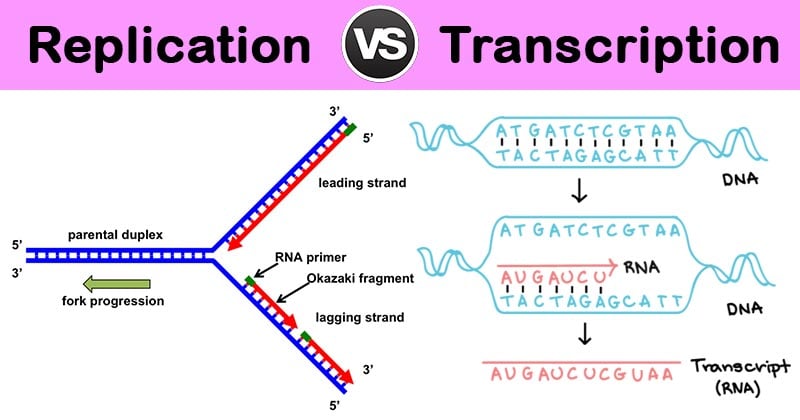DNA replication and transcription are fundamental genetic processes that are essential for cell growth and division.

Both DNA replication and transcription processes involve the generation of a new molecule of nucleic acids, either DNA or RNA; however, the function of each process is very different, with one involved in gene expression and the other involved in cell division.
Interesting Science Videos
Differences between DNA Replication and Transcription:
| S.N. | Character | DNA Replication | Transcription |
| 1. | Definition | DNA replication is the process of making new copies of DNA. | Transcription is the process by which DNA is copied (transcribed) to RNA. |
| 2. | Significance | DNA replication is important for properly regulating the growth and division of cells. | Transcription of DNA is the method for regulating gene expression. |
| 3. | Transfer of Genetic Information | From DNA to DNA | From DNA to RNA |
| 4. | Occurs during | S phase of cell cycle. | Occurs in the G1 and G2 phases of cell cycle. |
| 5. | Motive | Occurs in preparation for cell division. | Occurs in preparation for protein translation. |
| 6. | Involved in | Cell division | Gene expression |
| 7. | Raw Materials | dATP, dGTP, dTTP and dCTP serve as raw materials. | ATP, UTP, GTP and CTP serve as raw materials. |
| 8. | Template | Both DNA strands | Single DNA strand |
| 9. | Primers | Requires RNA primer to start replication. | No primer is required for initiation. |
| 10. | Enzymes Required | DNA Helicase, DNA Polymerase | Transcriptase (type of DNA Helicase), RNA polymerase |
| 11. | Unwinding and Splitting | It involves unwinding and splitting of the entire DNA molecule. | It involves unwinding and splitting of only those genes which are to be transcribed. |
| 12. | Base pairing | Adenine pairs with thymine. | Adenine pairs with uracil instead of thymine. |
| 13. | Copying of Template | The entire template strand is copied. | Only the portion of the template DNA that codes for required genes is transcribed, or copied. |
| 14. | Product | Two daughter DNA | mRNA, tRNA, rRNA and non-coding RNA( like microRNA) |
| 15. | Strands in product | Double stranded DNA | Single stranded RNA |
| 16. | Post-formation | Joining of Okazaki fragments | RNA editing |
| 17. | Processing | It produces normal DNA molecules that do not need any processing. | It produces primary RNA transcript molecule which needs processing to acquire final form and size. |
| 18. | Bond | Replicated DNA strand remains hydrogen bonded to its template DNA strand. | Transcribed RNA strand separates from its DNA template strand. |
| 19. | Migration from the site of formation | Products remain within nucleus. | Greater part of the product passes from nucleus into the cytoplasm. |
| 20. | Degradation of Product formed | Products are not degraded. | Products are degraded after their function is over. |
| 21. | Rate of Production | The rate of replication is typically 20 times faster than transcription and six or more replication forks may be present at the same time on the chromosome. | Comparatively slower. |
| 22. | Process followed by | Transcription/ Next replication | Translation. Although some RNA are the final product themselves. |
| 23. | Significance | Conserve the entire genome for next generation. | Necessary for protein synthesis. |
References
- https://microbiologyinfo.com/difference-replication-transcription/
- http://cdn.intechopen.com/pdfs/20630/InTechRelations_between_replication_and_transcription.pdf
- https://sciencing.com/difference-between-transcription-dna-replication-9038.html
- https://www.majordifferences.com/2013/10/difference-replication-vs-and.html
- https://www.atdbio.com/content/14/Transcription-Translation-and-Replication
- https://biodifferences.com/difference-between-replication-and-transcription.html

Thank you for this note its really helpful
This article is very clear. Thank you!
Well explained and understanding